Young farmers cotton on to high-tech help
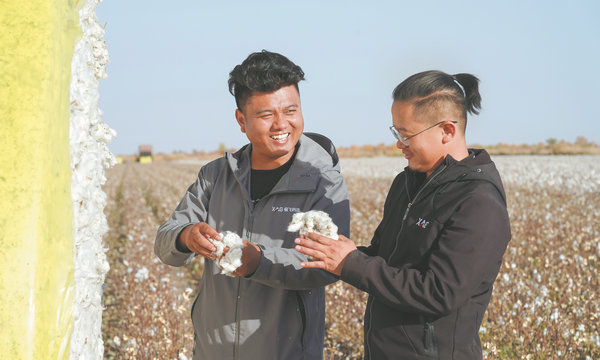
Ling Lei (left) and Ai Haipeng check crops on their Super Cotton Farm before harvesting. [Photo/seexinjiang.com]
It's about working smarter, not harder, Yang Yang and Mao Weihua report in Bayingolin Mongol autonomous prefecture, Xinjiang.
Thinking about the hard work that generations of Chinese farmers have gone through, working the land and tilling the fields, few young people would jump at the chance to take care of 3,000 mu (200 hectares) of cotton fields — equivalent to the size of 280 soccer pitches, especially as a beginner.
However, in the past three years, two young men, Ai Haipeng and Ling Lei, in their early 30s, have been working in Yuli county, Bayingolin Mongol autonomous prefecture of Northwest China's Xinjiang Uygur autonomous region, managing a 200-hectare Super Cotton Farm — and they are working smarter, not harder.
They come from XAG, a company based in Guangzhou, Guangdong province, devoted to developing smart agriculture.
This year in Xinjiang, 85 percent of the region's cotton has been harvested by machines, according to the Ministry of Agriculture and Rural Affairs. In the areas north of the Tianshan Mountains, cotton harvested by machines accounts for more than 97 percent of the processed total.
Sitting on the south of the Tianshan Mountains, Bayingolin now sees 93 percent of the 213,000 hectares of cotton fields plowed, sown and harvested by machines.
Covering an area of nearly 60,000 square kilometers, and enjoying more than 3,000 hours of sunshine every year, Yuli is one of the largest production bases of quality cotton in China. About 90 percent of its farmland, 70,000 hectares, is for cotton, 39 percent of which is well-facilitated farmland with irrigation capabilities and adequate harvest equipment, strictly limiting the use of chemicals.
But Ai and Ling manage the Super Cotton Farm with more advanced tools than merely seeders, plows, cotton-picking machines and irrigation facilities.
Overall, the management of a cotton field involves four steps: plowing the land, sowing, managing and harvesting.
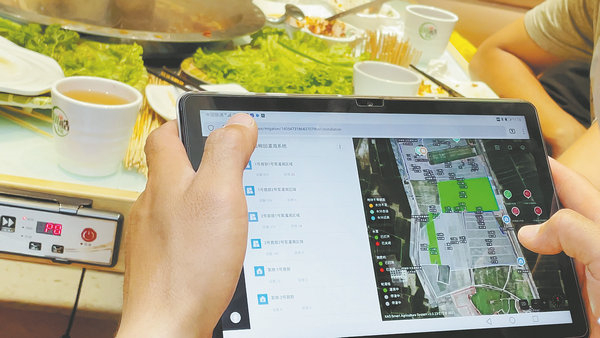
A smart agriculture management system used on the farm demonstrated on a tablet computer. [Photo/seexinjiang.com]
Farmers need to pay attention to all the factors that can affect the growth of cotton — temperature, moisture, rainfall, wind, air pressure and sunshine. They also need to be cautious about the weeds, pests and germination rate.
In traditional fields, farmers will go and check a particular plot when necessary. As early as January or February, they will start contacting long-term workers, asking them to help manage the cotton fields during the whole process, with free accommodation on offer to them.
A cotton filed as large as 200 hectares will need 20 to 30 long-term workers. They need to walk around the field every day to inspect the growth of the cotton plants, spot diseases and pests, making decisions about weeding and use of pesticides.
Now a drone can finish inspecting the whole field within a day.
When the Super Cotton Farm project was launched at the beginning of 2021, the duo first built a digital agricultural platform that employs the Beidou Navigation Satellite System, installing soil sensors in the field, meteorological stations, and cameras to form an agricultural internet of things.
Throughout the 140 days of the entire life cycle of cotton, the IoT would keep monitoring the plants and collecting images of the field and data about the weather and soil conditions.
In early spring, with high-precision navigation and autonomous driving technology, farm machines equipped with autopilot devices plowed and leveled the land automatically.
When it was time to sow, the IoT would send data about temperature and soil moisture to the smartphones of Ai and Ling, who would decide the sowing date. Later, they sent unmanned tractors to complete the task efficiently and precisely.
Then, remote-sensing drones rendered high-definition digital maps of the cotton field that facilitated unmanned aerial and ground vehicles to spray pesticides and fertilize the land.
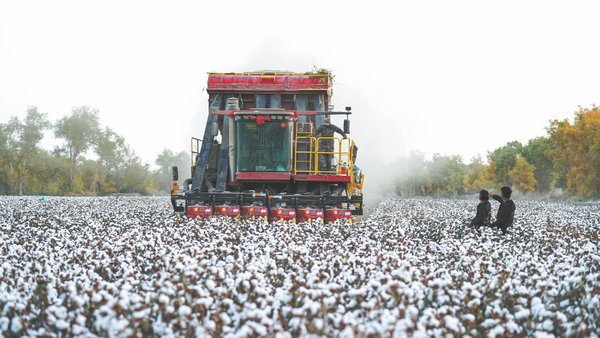
A cottonpicking machine in action. [Photo/seexinjiang.com]
On their phones, artificial intelligence would help assess the growth of the seedlings. If they saw that, somewhere, seedlings were missing or weeds had emerged, they would send robots to deal with the issue.
With lessons learned each year, they have further upgraded manuring technology and the automatic irrigation system, and improved the systems providing treatment and prevention of diseases and pests, as well as adding measures to shelter seedlings from strong winds.
The Super Cotton Farm, located in the north of Yuli, where the land is flat without effective large-scale wind-breaking measures, has to deal with strong, damaging winds from the northeast.
Unfamiliar with the environment at first, the duo were frustrated to find that strong winds killed half of the flourishing seedlings in April 2021.
However, with no time for tears, they swiftly replanted with support from XAG and intelligent machines.
To prevent similar problems, they have developed methods to shelter seedlings. In the following two years, they first grew wheat in mid-March before sowing cotton in early April when the wheat plants had grown above 10 centimeters, and had formed "walls" that could shelter the seedlings.
Starting in the summer, cotton plants enter the key growing period that lasts around four months.
"Irrigation and manuring are key to cotton cultivation, especially during this period, which needs the most labor and investment," Ai says.
In the traditional management pattern, cotton farmers would usually need to spend a lot of time and energy looking for more experienced workers to help with irrigation, fertilization, the prevention and treatment of diseases and pests, as well as monitoring the crop's growth.
On the Super Cotton Farm, however, all of that work was completed by robots and AI.
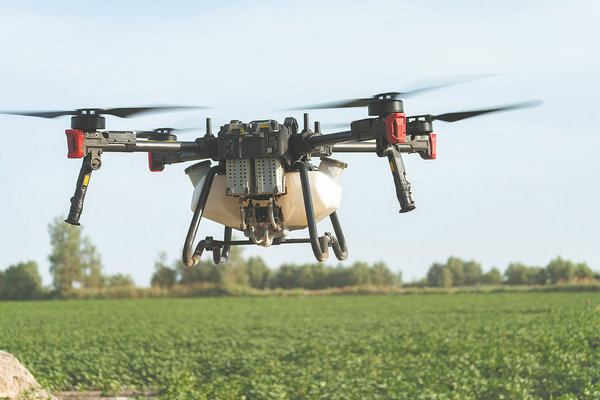
An agriculture drone. [Photo/seexinjiang.com]
The IoT can accurately issue pest warnings for early intervention by unmanned aerial vehicles, reducing overall pesticide use. Remote-sensing drones can create weed distribution maps, guiding precise herbicide application to significantly cut down on its usage.
In 2021, during irrigation, Ai walked more than 10 km a day to open the valves of the traditional irrigation system. There were more than 40 hydrants and he had to look for them one by one. To free himself from this toil, he upgraded them to intelligent valves.
More than 100 soil sensors are positioned across the field, alerting farmers when the soil moisture drops while transferring data to the automatic irrigation system, which will then open the smart electric valves to water the plants, stopping as soon as the soil moisture reaches the correct levels.
Solid fertilizer has been replaced by fluid fertilizer, so there is no need for workers to guard the stocks. Instead, they mix the fertilizer with water and feed the plants through the irrigation system. By operating on a tablet computer, Ai and Ling can manure the land easily and accurately, largely saving water and fertilizer.
"Compared with the traditional pattern, we don't need long-term workers. About 80 percent of our daily work, such as irrigation, manuring, weeding and pesticide spraying, can be completed by machines," Ai says.
In general, compared with traditional cotton planting, Ai and Ling reduced pesticide usage by 36 percent, water by 60 percent and labor by 93 percent.
Before harvesting, they use drones, rather than wheeled machines, to spray defoliant, so as to prevent plants from being crushed. A drone completes the whole task in two to three days. In comparison, it would take 10 days using tractors.
This year, Ai and Ling harvested a total of 1,191 metric tons of cotton, that is, 420.9 kilograms per mu, compared with the 403.6 kg per mu last year.
In 2022, costs at Super Cotton Farm were about 2,379 yuan ($333.3) per mu, a drop of 419.6 yuan compared with traditional large-scale cotton fields nearby. This year, they have cut costs by a further 180 yuan per mu.
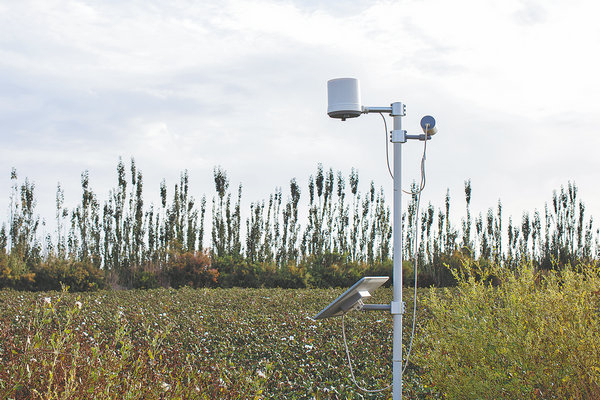
Internet of things facilities. [Photo/seexinjiang.com]
The success last year attracted others to emulate the management method of Super Cotton Farm. Yang Xiaojia, now 36, who returned from Chongqing to his hometown in Yuli in 2019, took over the family's 133.3-hectare cotton field.
Yang used to work in the financial industry, and, as a beginner, he was confronted with too many questions and problems: How to assess the growth of the cotton? How to prevent and control diseases, pests, and weeds? How to supervise the labor of workers? How to effectively reduce cost, especially in irrigation?
Inspired by the Super Cotton Farm, Yang introduced its management method at the beginning of this year. Compared to previous years, the automatic irrigation system largely reduced the labor costs by 34.7 percent. The cost of electricity and water also fell by 22.3 percent, and that of pesticide by 20 percent.
Last year, 29-year-old Mo Xiaoyu, also from XAG, rented 33.3 hectares in Xinjiang to grow cotton using the methods espoused by Ai and Ling. It was her first time working on a farm. "Wherever I am, I need only a smartphone to manage my cotton field," she said in a previous interview.
At the end of October last year, cotton output in her field reached 403.6 kg per mu and the cotton fiber grew to 30 millimeters, qualified A-class.
While this method can be copied on large-scale farmland of 15.94 hectares and above to achieve more profit, Ai and Ling are marching toward the output goal of 500 kg per mu.
To promote the upgrading of Smart Cotton Farm, in recent years, Yuli has introduced smart systems that cover 16,667 hectares of cotton fields. With AI and automatic irrigation systems, cotton farmers in the county, on average, save 250 yuan per mu in irrigation and the utilization rate of fertilizer has also improved by 30 percent.
With the consumption of 30 percent less fuel oil and 36 percent less pesticide, the management method of Super Cotton Farm reduces the emission of greenhouse gases by 22 percent.
"In the future, we will conduct similar experiments on large-scale fields of corn, wheat and rice, in different places," Ai says.
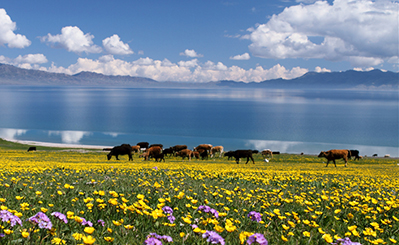 Attractions
Attractions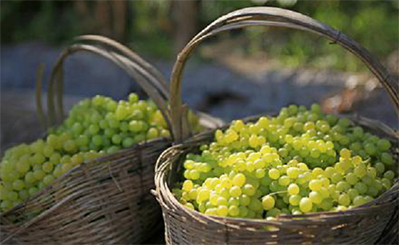 Dining
Dining Culture
Culture